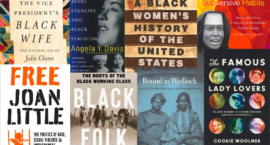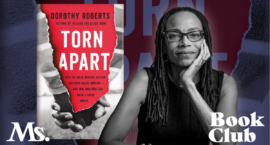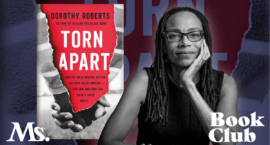A list of recommended readings—all written by women—that shed light on the richness and complexity of the Black experience in the United States
Tag: Family
Issues of the family, including childcare, welfare and family responsibilities, often directly impact women as mothers and primary caretakers.
2023 ‘Best of the Rest’: Our Favorite Books of the Year!
Each month, we provide Ms. readers with a list of new books being published by writers from historically excluded groups. And each year, we review our monthly Reads for the Rest of Us lists and choose our favorite books of the entire year.
You’ve read the other “Best of” lists—now read the other one. You know, for the rest of us. So here they are, our book critic’s top 38, in alphabetical order.
Reimagining Child Welfare: The Ms. Q&A with Dorothy Roberts, Host of Podcast ‘Torn Apart’
Professor Dorothy Roberts worked for decades to try to fix the child welfare system—but she came to the understanding that the system could not be fixed: It had to be abolished. Ms. sat down with her to discuss how abolishing the child welfare system is an issue of reproductive justice for women and their families, and the importance of educating about the injustices of the child welfare system.
All episodes of Torn Apart are available here or wherever you get your podcasts.
Rest in Power: Rosalynn Carter—Feminist, First Lady, and ERA and Mental Health Advocate
In the many tributes written since Rosalynn Carter’s death on Nov. 19, one word often is used to describe her: trailblazer. Indeed, Rosalynn Carter was like no other first lady. She testified before Congress on mental health issues; made policy proposals on caregiving and established the Rosalynn Carter Institute for Caregivers in 1987; worked to advance women’s rights; and helped in the ratification of the Equal Rights Amendment.
Carter’s own words are the most powerful about her belief and commitment to equality. “Although there has been progress, women still struggle to take their full, rightful places in politics, the media, business and athletics. … I would like for people to think that I took advantage of the opportunities I had and did the best I could.”
‘Torn Apart’: Ms. Magazine Podcast Shows How the U.S. Welfare System Destroys Black Families
On Monday, Ms. Studios is dropping a brand-new podcast: Torn Apart: Abolishing Family Policing and Reimagining Child Welfare, hosted by Dorothy Roberts, which investigates how the U.S. child welfare system destroys Black families.
Over four episodes, Professor Roberts brings listeners front and center with the oppressive child protection system and what we need to do to reimagine child welfare.
Women Reporting on Ukraine for WaPo Win IWMF’s Courage in Journalism Award
This year, the International Women’s Media Foundation honored the women of the Washington Post covering the Ukraine, with the Courage in Journalism award.
“What’s frustrating to me is that men [soldiers] might take me less seriously, or won’t take me to the frontlines because I’m a woman,” said Ukraine bureau chief Isabelle Khurshudyan. “That aspect definitely exists, that definitely happens. You have to try and show your credentials. Other women will try to slip in other work they’ve done.”
Barbie and My Midlife Crisis
This year has found me clinging to youth with more gusto than ever. One of my kids mused, “Why can’t you be like other middle-aged people?” I shrugged, but I guess it’s because I think you’re either young or old. And I know which one I’d choose. Then I saw Barbie.
Greta Gerwig’s film has been labeled a feminist triumph (or failure) and a manifesto against (or tool of) corporate capitalism, but for me, it’s all about my midlife crisis (or “transition” to be kind). In the film, Barbie finds herself having irrepressible thoughts of death—and before she knows it, her perfect body and her dream world start showing signs of Real World flaws. Outside of Barbieland, much of our collective panic about dwindling youth stems from a culture that glorifies being young while rendering older people—particularly women—invisible.
‘Family Annihilators’: When Conservative America’s Fetish for Guns and Patriarchy Turns Deadly
Every five days, a person murders his family. We see these killings so much more often in conservative states, where guns are easy to get and there’s a higher concentration of sexist, insecure men who expect their wives to behave.
The U.S. is a global outlier when it comes to gun deaths. in much of the world, violent, misogynist men cannot easily get their hands on deadly weapons. In the U.S., they can—and the Supreme Court may make that even easier.
Welfare Is a Human Right: How Black Mothers Fought Their Own War on Poverty With Annelise Orleck
In her book, Storming Caesars Palace: How Black Mothers Fought Their Own War on Poverty, Annelise Orleck not only shares the history of Clark County Welfare Right Organization’s (CCWRO) ascent and activism but also provides an insightful guide to community organizing.
“I loved the CCWRO’s insistence that poor women are experts on poverty and can run their own programs better than so-called professionals. And they did! … They demanded to know why a state that took tax revenue from gambling and prostitution was considered morally acceptable, but mothers trying to feed their kids were called cheaters. They were fearless.”
Recognizing Our Essential Workers: The Women of the Long-Term Care Industry
Long-term care workers like myself—an industry that is almost entirely women of color—are some of the most disrespected, unprotected and underpaid workers in the country.
On Tuesday, President Biden signed an executive order to improve care and support care workers—the most comprehensive action yet to address this industry in crisis. This is a great first step, and I hope for the sake of my community and our loved ones that this starts to pave the way for necessary change. We will take this win and use it to motivate our continued fight.












